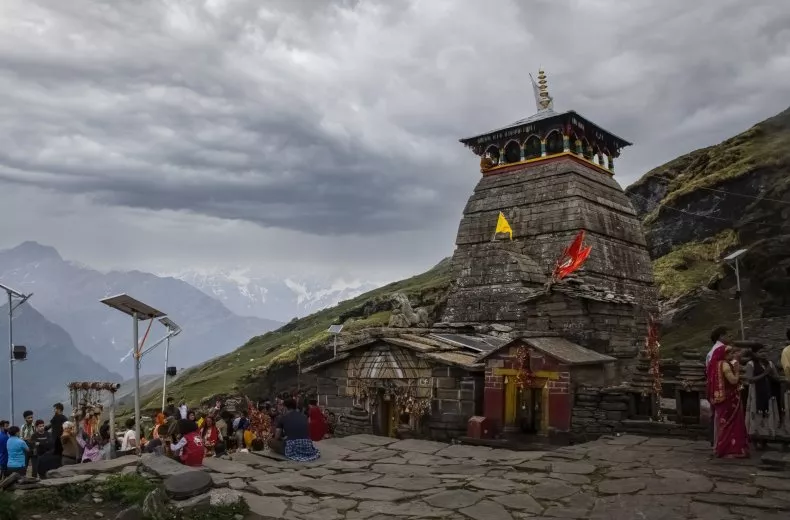Tungnath is one of the highest Shiva temples in the world and is the highest of the five Panch Kedar temples located in Rudraprayag district. Getty Images
Tungnath Temple Shiva India Faces Critical Safety Warning After Monsoon Damage
Indian authorities have issued an urgent safety warning for travelers planning to visit the Tungnath Temple, the highest Shiva temple in the world. The warning was issued after heavy monsoon rains caused significant damage to the temple, located in the Rudraprayag district of Uttarakhand. This advisory was shared on October 2, urging visitors to avoid the area due to the site’s compromised structural integrity.
The Tungnath Temple, a sacred site dedicated to Lord Shiva, is perched at an altitude of 3,680 meters. It has long been a revered destination for both pilgrims and tourists. However, the relentless monsoon season, which spans from June to September, has severely affected the temple’s structure. Extensive water exposure has weakened the foundation, and the walls have become unstable, according to reports from The Economic Times.
The temple’s construction, primarily using slate bricks and slabs, has made it particularly vulnerable to the harsh weather conditions. The head of the Badrinath Kedarnath Temple Committee, Ajendra Ajay, highlighted these dangers in a statement, warning of serious subsidence and shifting wall slates that have worsened the situation. The water leakage during the rainy season has accelerated the damage, making the site increasingly unsafe for visitors.
Uttarakhand’s Tourism Minister, Satpal Maharaj, echoed these concerns. He reassured the public that the government is prioritizing the temple’s restoration. Immediate steps are being taken to address the structural issues and ensure the temple remains safe for all who wish to visit. Local authorities have already contacted the Geological Survey of India and the Central Building Research Institute for expert assistance in repairing the damage.
The Tungnath Temple is not only a popular religious site but also holds great cultural significance. It is the highest of the five Panch Kedar temples, a group of shrines in the Himalayan region, each dedicated to Lord Shiva. Known as the “lord of the peaks,” Shiva is one of the most important deities in Hinduism, central to the Shaivism sect. Devotees flock to this temple year-round to pay homage to Shiva, who is revered as the destroyer and transformer within the Hindu trinity, which also includes Brahma and Vishnu.
Despite its cultural significance, the temple’s high altitude makes it more susceptible to damage from natural elements than other religious sites. The monsoon season, which brings about 90 percent of India’s annual rainfall, has been particularly devastating in recent years. Climate change has also been cited as a contributing factor to the worsening monsoons, with erratic weather patterns causing heavier rainfall than usual. Some reports, including one from The Economist in 2021, suggest that rainfall in India could increase by 5.5 percent due to climate change, further threatening ancient structures like the Tungnath Temple.
The Badrinath Kedarnath Temple Committee, which oversees the maintenance of these temples, has expressed its commitment to restoring Tungnath. However, they have urged the public to refrain from visiting until the repairs are completed and the site is declared safe. In a region where religious tourism is a major part of the economy, these safety warnings are essential to prevent accidents and ensure the well-being of visitors.
Monsoon-related damage to historical and religious sites is not uncommon in India, but the situation at Tungnath is particularly severe. Due to the temple’s location in the Himalayan mountains, it is more exposed to the elements, which accelerates wear and tear. The combination of rainwater, shifting foundations, and weakened walls has made the temple extremely fragile, posing a significant risk to anyone in the vicinity.
The committee and local authorities are now focused on preventing further deterioration and ensuring the temple’s long-term preservation. Repairs are expected to begin as soon as possible, but the extent of the damage means that the restoration process may take time. For now, those hoping to visit Tungnath are advised to make alternative travel plans and stay informed about the temple’s status.
The Tungnath Temple has stood for centuries as a symbol of devotion and faith. However, the challenges posed by extreme weather and natural degradation underscore the need for proactive preservation efforts. As climate change continues to impact regions like Uttarakhand, the preservation of ancient structures like Tungnath will require ongoing attention and resources.
In the meantime, the safety of visitors remains the top priority. Authorities will continue to monitor the situation closely and provide updates on the temple’s condition. Travelers are encouraged to respect the safety warnings and avoid the area until the site is deemed secure once again.
#TungnathTemple #ShivaTemple #MonsoonDamage #UttarakhandTravel #TempleSafety
